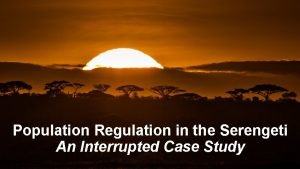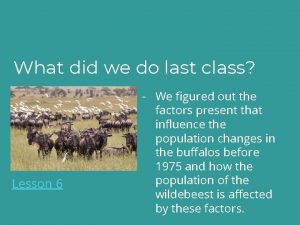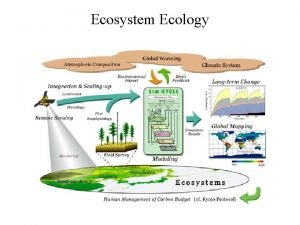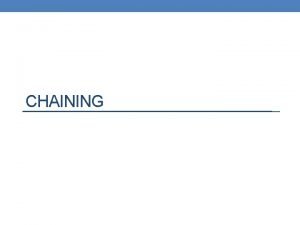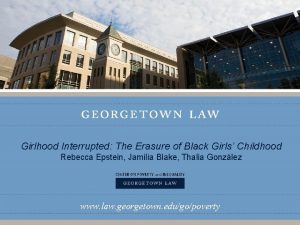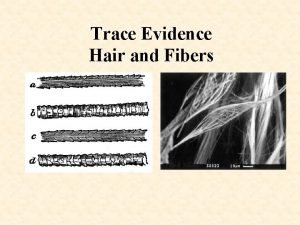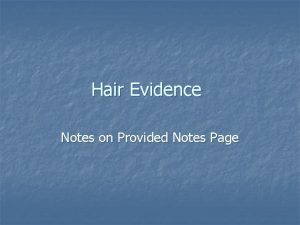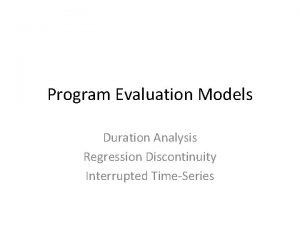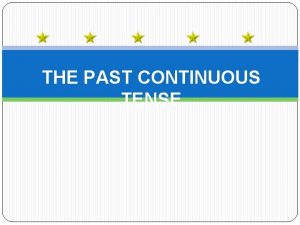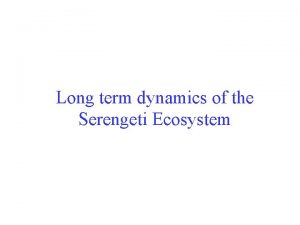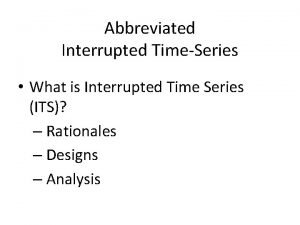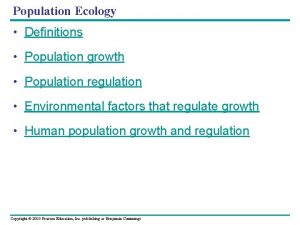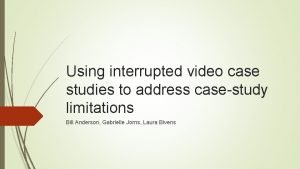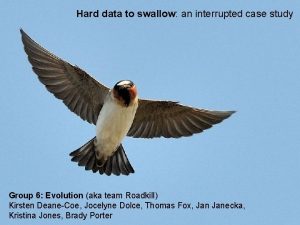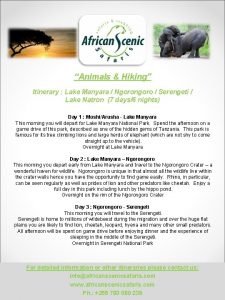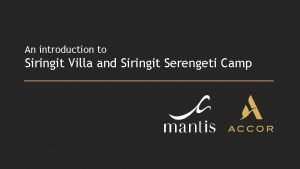Population Regulation in the Serengeti An Interrupted Case




















- Slides: 20

Population Regulation in the Serengeti An Interrupted Case Study Population Regulation in the Serengeti Slide 1 of 20

Populations in Serengeti National Park Speaking: Tony Sinclair, University of British Columbia Population Regulation in the Serengeti Slide 2 of 20

Factor Bottom-up or topdown? Density-dependent or independent? Top-down What Controls a Population’s Size? Bottom-up Population Regulation in the Serengeti Slide 3 of 20

Bottoms-up! Wildebeest (nonmigratory) Which of the following is a bottom-up factor that could impact the population sizes of these herbivores? a. predators, like lions b. parasites c. rainfall d. earthquakes Buffalo Wildebeest (migratory) Population Regulation in the Serengeti Slide 4 of 20

What Happened to Migratory Wildebeest? (1958– 1978) Speaking: Tony Sinclair, University of British Columbia Population Regulation in the Serengeti Slide 5 of 20

Migratory Wildebeest from 1958– 1978 (Part A) ● ● Which symbol represents the number of wildebeest? Which represents the prevalence (%) of wildebeest with rinderpest? How do you know? Population Regulation in the Serengeti Slide 6 of 20

Migratory Wildebeest from 1958– 1978 (Part B) The elimination of rinderpest impacted the wildebeest population. What type of factor is rinderpest? a. density-independent, top-down b. density-independent, bottomup c. density-dependent, top-down d. density-dependent, bottom-up Population Regulation in the Serengeti Slide 7 of 20

Migratory Wildebeest from 1958– 1978 (Part C) Consider the population growth curve shown. What type of growth is this? a. exponential b. linear c. logistic d. geometric ● What would happen to the population in the long term? Population Regulation in the Serengeti Slide 8 of 20

What Happened to Migratory Wildebeest? (1978– 2003) Speaking: Tony Sinclair, University of British Columbia Population Regulation in the Serengeti Slide 9 of 20

Migratory Wildebeest from 1978– 2003 (Part A) Consider the entire population growth curve shown. What type of growth is this? a. exponential b. linear c. logistic d. geometric Population Regulation in the Serengeti Slide 10 of 20

Migratory Wildebeest from 1978– 2003 (Part B) What is the approx. carrying capacity of the wildebeest population? a. 800, 000 b. 900, 000 c. 1, 300, 000 d. 1, 500, 000 Population Regulation in the Serengeti Slide 11 of 20

Migratory Wildebeest from 1978– 2003 (Part C) ● ● In 1958, the wildebeest population was small due to rinderpest. What factors affected the population from 1980– 2000? Were they density-dependent or density-independent? Population Regulation in the Serengeti Slide 12 of 20

What Happened to Nonmigratory Wildebeest? (Part A) This figure explores how predators impact nonmigratory populations of Serengeti herbivores. ● What might explain the relationship between predation and herbivore weight? Species shown are the oribi (O), impala (I), topi (T), zebra (Z), African buffalo (B), giraffe (G), black rhino (R), hippo (H), and African elephant (E). Population Regulation in the Serengeti Slide 13 of 20

What Happened to Nonmigratory Wildebeest? (Part B) This figure explores how predators impact nonmigratory populations of Serengeti herbivores. ● Some populations have low rates of predation. What factors are likely to limit their size? Species shown are the oribi (O), impala (I), topi (T), zebra (Z), African buffalo (B), giraffe (G), black rhino (R), hippo (H), and African elephant (E). Population Regulation in the Serengeti Slide 14 of 20

What Happened to Nonmigratory Wildebeest? (Part C) What percentage of nonmigratory wildebeest deaths are caused by predation? a. 100% b. 85% c. 45% d. 25% Species shown are the oribi (O), impala (I), topi (T), wildebeest (W), zebra (Z), African buffalo (B), giraffe (G), black rhino (R), hippo (H), and African elephant (E). Population Regulation in the Serengeti Slide 15 of 20

What Limits the Migratory Wildebeest Population? Speaking: Simon Mduma, Tanzania Wildlife Research Institute Population Regulation in the Serengeti Slide 16 of 20

How Does Migration Impact Population Regulation? Speaking: Grant Hopcraft, University of Glasgow Population Regulation in the Serengeti Slide 17 of 20

The Benefits of Migration (Part A) Migratory wildebeest populations are limited by factors that are: a. density-independent, top-down b. density-independent, bottom-up c. density-dependent, top-down d. density-dependent, bottom-up Population Regulation in the Serengeti Slide 18 of 20

The Benefits of Migration (Part B) Nonmigratory wildebeest populations are limited by factors that are: a. density-independent, top-down b. density-independent, bottom-up c. density-dependent, top-down d. density-dependent, bottom-up ● Why? Population Regulation in the Serengeti Slide 19 of 20

Apply What You’ve Learned… ● ● What factors might limit migratory versus nonmigratory populations of other animals in the Serengeti, such as zebras? Think of a population outside the Serengeti that you are familiar with, maybe one that lives near you. What factors do you think limit the size and growth of the population you chose? Why? Population Regulation in the Serengeti Slide 20 of 20
 Serengeti
Serengeti Http://serengeti.inquiry-hub.net/
Http://serengeti.inquiry-hub.net/ Nutrient cycle in the serengeti
Nutrient cycle in the serengeti Best worst and average case
Best worst and average case Population ecology section 1 population dynamics
Population ecology section 1 population dynamics Chapter 4 population dynamics study guide answers
Chapter 4 population dynamics study guide answers Chapter 4 population ecology section 1 population dynamics
Chapter 4 population ecology section 1 population dynamics Section 1 population dynamics answer key
Section 1 population dynamics answer key Is hair class evidence
Is hair class evidence Behavior chain interruption strategy
Behavior chain interruption strategy Medulla types
Medulla types Girlhood interrupted
Girlhood interrupted Hair growth
Hair growth Interrupted horizontal mattress
Interrupted horizontal mattress Medulla pattern with one unbroken line of color
Medulla pattern with one unbroken line of color Interrupted medulla
Interrupted medulla Interrupted time series vs regression discontinuity
Interrupted time series vs regression discontinuity Girl, interrupted
Girl, interrupted Past continuous were was
Past continuous were was Interrupted projection definition geography
Interrupted projection definition geography Interrupted medulla
Interrupted medulla
